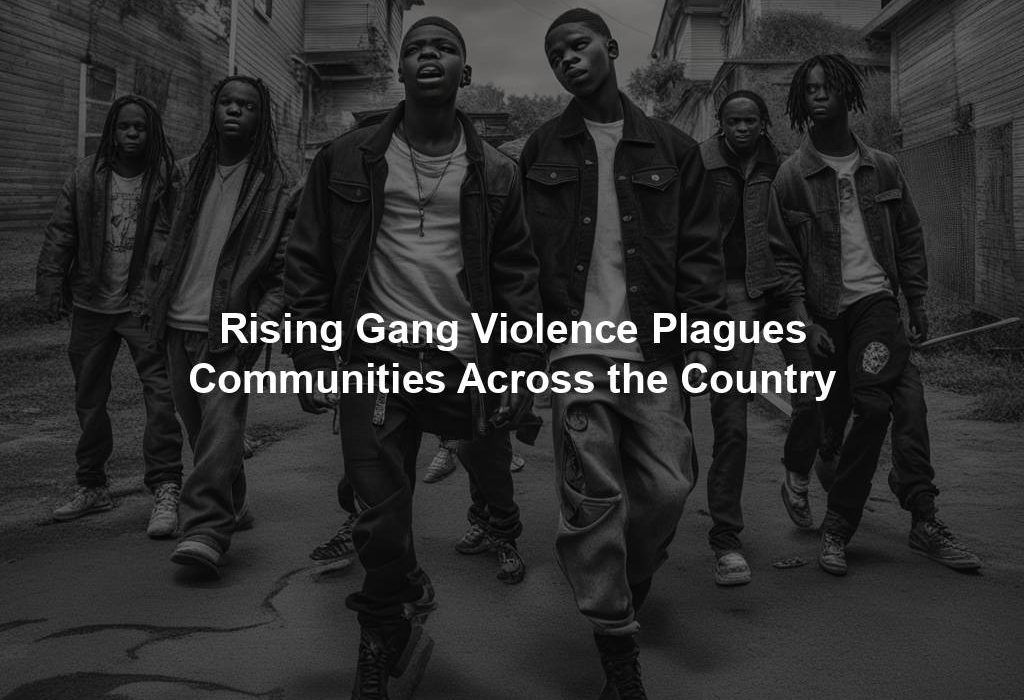Rising Gang Violence Plagues Communities Across the Country
In recent years, there has been a disturbing trend of increasing gang violence in communities across the United States. From major cities to rural towns, gangs are causing havoc and instilling fear in residents. The impact of gang violence goes far beyond the immediate victims, as it can have ripple effects on schools, businesses, and overall community safety. This article will explore the factors contributing to the rise in gang violence, the consequences for communities, and potential solutions to address this pressing issue.
Factors Contributing to the Rise in Gang Violence
There are several factors that have contributed to the increase in gang violence in the United States. One of the main drivers is the proliferation of gang activity fueled by drug trafficking. Gangs are heavily involved in the distribution of illegal drugs, which not only fuels their criminal activities but also leads to turf wars and violent confrontations between rival gangs.
In addition to the drug trade, social and economic disparities play a significant role in the recruitment and retention of gang members. Many gangs target marginalized and disadvantaged youth who may not have access to opportunities for education and employment. Joining a gang can provide a sense of belonging and identity for these individuals, as well as a source of income through criminal activities.
The easy availability of firearms also contributes to the escalation of gang violence. Many gang members have easy access to guns, which increases the likelihood of lethal confrontations and escalates the level of violence in gang conflicts. Gun violence is a major concern in communities affected by gang activity, with innocent bystanders often becoming victims of stray bullets.
Consequences of Gang Violence for Communities
The consequences of gang violence for communities are far-reaching and devastating. Beyond the immediate physical harm caused by shootings and other violent acts, gang violence can have long-lasting impacts on the social fabric and economic stability of a community. Businesses may be hesitant to invest in areas plagued by gang activity, leading to a decline in economic opportunities and job creation.
Schools in communities affected by gang violence may struggle to provide a safe and conducive learning environment for students. Fear of violence can lead to decreased attendance and academic performance among students, perpetuating a cycle of poverty and crime. The presence of gangs in neighborhoods can also erode trust and social cohesion among residents, leading to a breakdown of community ties and support networks.
Moreover, the trauma of living in an environment characterized by gang violence can have lasting psychological effects on individuals and families. Children growing up in communities plagued by gang activity may suffer from anxiety, depression, and post-traumatic stress disorder, which can impact their mental health and well-being for years to come.
Solutions to Address Gang Violence
Addressing gang violence requires a comprehensive and multi-faceted approach that involves collaboration between law enforcement, community organizations, and government agencies. One key strategy is to focus on prevention and intervention efforts that target at-risk youth and provide them with positive alternatives to gang involvement. Programs that offer mentorship, job training, and educational support can help steer young people away from gangs and towards a brighter future.
Community policing initiatives can also be effective in building trust between law enforcement and residents, helping to deter gang activity and improve overall public safety. By working closely with community members, police can gather valuable intelligence on gang-related activities and disrupt criminal operations before they escalate into violence.
Another important aspect of addressing gang violence is to invest in social services and support systems that can help individuals leave gangs and rebuild their lives. Services such as counseling, job placement, and housing assistance can provide a pathway out of gang involvement for those who are willing to change their ways.
Furthermore, addressing the root causes of gang violence, such as poverty, lack of educational opportunities, and limited access to mental health services, is essential to creating safer and more resilient communities. By addressing these underlying issues, we can create a more equitable society where all individuals have the opportunity to thrive and succeed.
Conclusion
In conclusion, the rise in gang violence in communities across the United States is a complex and pressing issue that requires urgent attention and action. By addressing the factors contributing to gang violence, understanding the consequences for communities, and implementing solutions that focus on prevention and intervention, we can work towards creating safer and more vibrant communities for all residents. It is imperative that we come together as a society to address this challenge and ensure that every individual has the opportunity to live in a safe and supportive environment.




